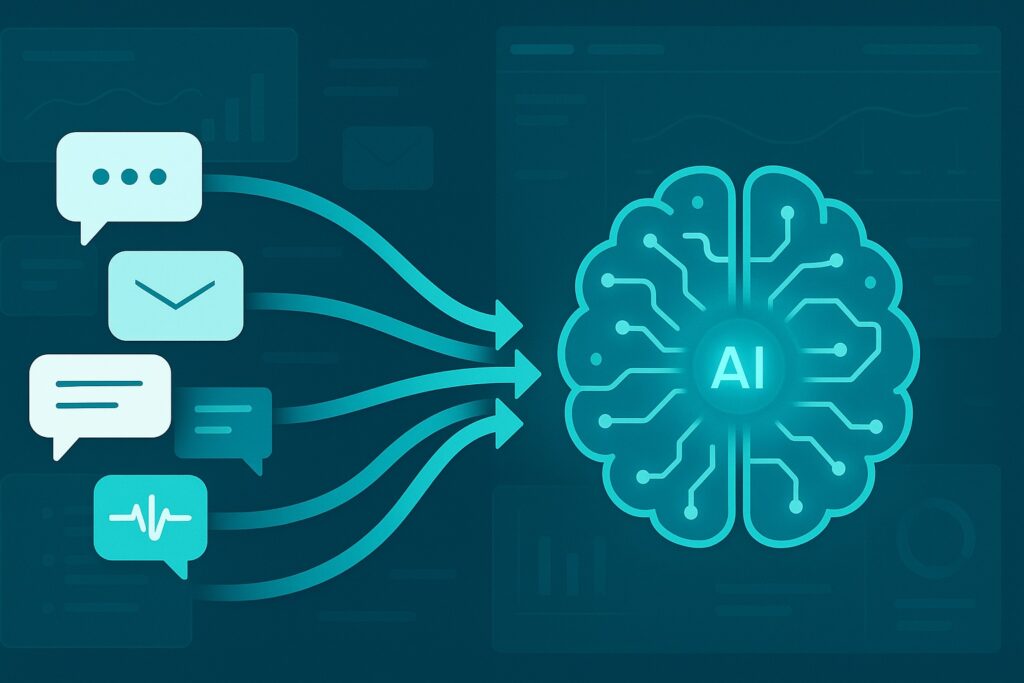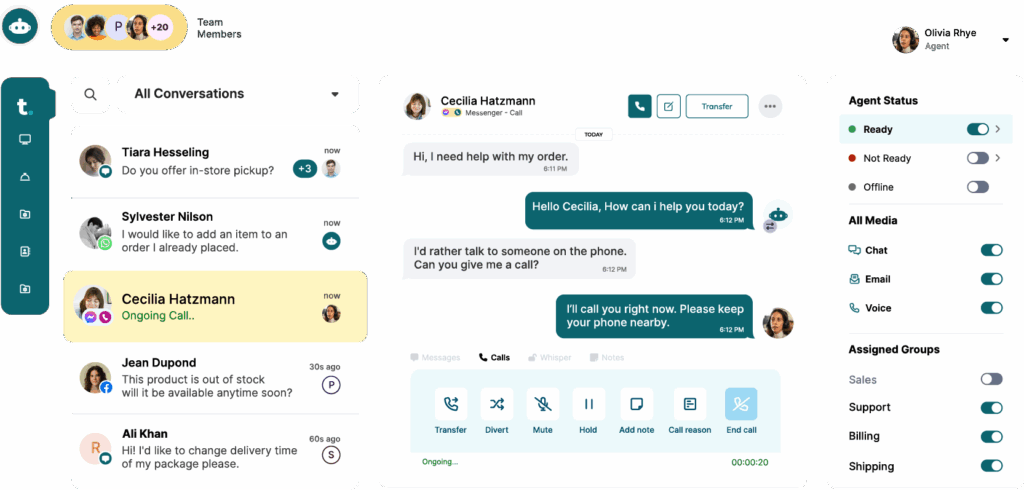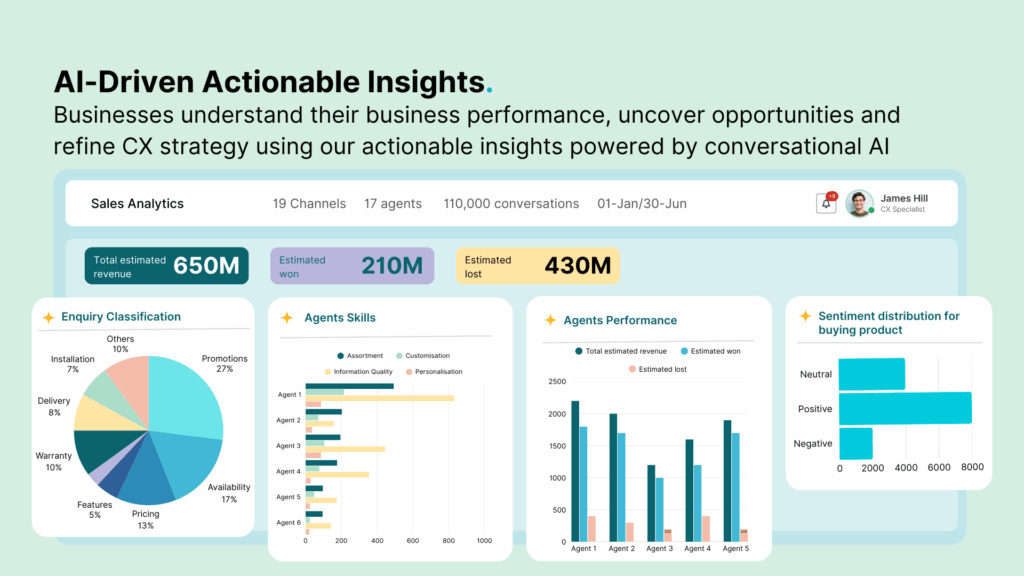In today’s digital landscape, delivering exceptional customer experience (CX) at scale is both critical and challenging. Business leaders increasingly recognize that artificial intelligence (AI) is key to meeting rising customer expectations. In fact, 65% of CX leaders see AI as a strategic necessity, rendering older customer service approaches obsolete . But AI doesn’t operate in a vacuum – its success hinges on the quality of data and interactions fueling it. This is where customer conversations become invaluable. Every chat, email, and call with a customer holds insights that can help shape smarter, more scalable AI solutions. By tapping into these conversations, companies can train AI to be more responsive, personal, and efficient in customer service. Whether you’re in ecommerce, insurance, digital services, or a tech startup, leveraging real customer dialogues can transform AI from a buzzword into a practical driver of outstanding CX.
Customer Conversations: The Blueprint for AI-Powered CX
Front-line conversations with customers are a treasure trove of information. Support chats, phone calls, and social media interactions all contain unfiltered feedback – questions, pain points, preferences – that reveal what customers truly care about. Modern conversation analytics tools use AI (natural language processing) to analyze these support interactions at scale, extracting common themes and sentiments . The result is granular, actionable insights that can guide improvements in products, services, and support processes. For example, if an insurance hotline receives numerous inquiries about a specific policy clause, that pattern can signal an opportunity to clarify documentation or train a bot to handle those questions. In digital services, analyzing chat transcripts might uncover a frequently reported bug, prompting a proactive fix. By listening to customers’ voices, businesses essentially get a blueprint for where AI and automation can make the biggest impact. It ensures that when you deploy AI in customer experience, it’s tackling the issues that matter most to your customers. This alignment between real customer needs and AI capabilities is what makes CX initiatives truly scalable – as your customer base grows, your AI is already tuned to respond effectively. The companies that excel here treat customer conversations as a continuous feedback loop, using them to train algorithms, refine chatbot responses, and personalize experiences over time . In short, scalable AI in CX starts with understanding people, and there’s no better way to understand people than to genuinely hear what they’re saying.

Omnichannel Engagement and the Power of a Unified Inbox
Customers today interact with businesses across a plethora of channels – web chat, email, phone, SMS, WhatsApp, Facebook, and more. They expect a seamless experience no matter which medium they use. Studies show nearly 80% of customers prefer omnichannel strategies for the seamless communication experience . If these conversations stay fragmented in channel-specific silos, support agents struggle to piece together context, and AI systems miss the full picture. This is why a Unified Inbox is so crucial. A unified inbox brings all customer conversations from every channel into one view, acting as a single pane of glass for support teams. Agents can see the entire customer journey – that means the email a customer sent yesterday, the live chat they started today, and their tweet from last week all appear in one continuous thread. This omnichannel context not only prevents issues from falling through the cracks, but also provides rich data for AI to learn from. When you integrate a unified inbox, your AI and analytics can draw on 360-degree customer context, leading to more accurate responses and recommendations.
The benefits of this approach are tangible. For instance, one ecommerce brand that consolidated its web, social, and messaging interactions into a unified, AI-powered platform saw rapid improvements – within weeks they achieved 30% faster response times and higher agent efficiency without adding headcount . By eliminating channel silos, they turned slow, fragmented support into a cohesive, responsive operation. A unified inbox also makes life easier for agents, reducing the stress of jumping between tools and enabling faster resolutions (which customers certainly notice). For a busy ecommerce retailer during peak season or a high-touch digital services provider, this can be the difference between overwhelmed support staff and smooth, scalable service delivery. Ultimately, omnichannel conversation management through a unified inbox sets the foundation for scalable AI – it ensures AI has consistent data to learn from and that customers get consistent service across channels.

Conversational AI and AI Chatbots: Scaling Customer Interactions
While live agents are invaluable, they simply cannot handle every customer issue instantly, especially as a business scales. This is where Conversational AI and intelligent bots come into play. AI-driven chatbots have become a cornerstone of scalable customer service, capable of engaging customers in human-like dialogue and resolving routine queries autonomously. Industry research underscores this shift: by 2024, 85% of customer interactions will be handled by chatbots, reducing the need for human intervention in many cases . These AI Chatbots are available 24/7, providing instant answers at any hour and freeing up human agents to focus on more complex, high-value cases. The result is faster service for customers and a huge boost in capacity for the support team.
Real-world examples illustrate how impactful conversational AI can be. In the ecommerce sector, retail giant Walmart deployed AI chatbots to assist with tasks like order tracking and returns. The outcome? They managed to reduce customer service calls by over 38%, significantly speeding up service while easing the load on call centers . This kind of reduction in repetitive inquiries means human agents can concentrate on personalized advice or difficult issues, improving overall service quality. Meanwhile, in the insurance industry, AI is revolutionizing how claims are handled. Lemonade, a tech-driven insurer, famously uses an AI chatbot for claim processing. Their bot (aptly named AI Jim) can approve simple claims in as little as two seconds, and now nearly half of all Lemonade’s claims are handled by AI – a feat that was unimaginable until recently . This ultra-fast, automated service not only delights customers who get near-instant resolutions, but it also allows the company to scale up its customer base without a linear increase in support staff.
For digital service providers and tech startups, conversational AI levels the playing field. A startup can serve a global customer base with always-on chat support, even with a small support team, by letting chatbots field the bulk of inquiries. The key is that these bots aren’t just FAQ machines – modern conversational AI can understand context, detect customer sentiment, and hand off to human agents at the right moment if needed. They learn from every interaction, especially when connected with a unified inbox and analytics. Over time, a well-trained chatbot becomes an expert on the common questions in your business domain. Integrating Conversational AI into your support strategy means your customer service scales up without sacrificing quality or human touch. It’s like having a virtual team of agents that grows with your business demand. The end result is faster responses, greater consistency, and customers who feel heard and helped, not waiting in queues.
No-Code Automation and CX Analytics for Continuous Improvement
Deploying AI and chatbots is not a one-and-done endeavor – the most successful customer experience strategies involve continuous improvement and agility. This is where No-Code Automation and robust CX Analytics become game-changers. With a No-Code Automation platform, businesses can rapidly design and tweak their customer service workflows, chatbot dialogs, routing rules, and more without writing a single line of code. Why does that matter? Because the faster you can implement changes, the faster you can respond to new insights from customer conversations.
Not every company has an army of developers on hand, especially not lean tech startups or non-tech enterprises like insurers and retailers. No-code tools empower customer experience teams and subject-matter experts to turn their ideas into automation flows in hours or days, not weeks. In fact, the adoption of no-code/low-code is soaring – by 2025, 70% of new business applications will use no-code technologies . This trend reflects how vital agility is: companies are ditching heavy development cycles for faster, easier ways to build solutions. With drag-and-drop builders and pre-built templates, a team can quickly create a workflow that, say, automatically sends a follow-up message and a feedback survey after a support ticket is solved, or integrates a new messaging channel when customers start using it.
Equally important is having strong analytics to guide these optimizations. CX Analytics involves tracking and analyzing customer experience metrics across all those conversations and touchpoints. This includes everything from real-time dashboard metrics for supervisors (like conversation volumes, response times, CSAT scores) to deeper analysis of text and sentiment trends. Armed with analytics, companies can identify what’s working and what’s not. For instance, analytics might reveal that tech support queries spike every Monday morning, or that customers in the digital services sector are often frustrated by a particular app feature – insights like these are gold for continuous improvement. A platform with integrated analytics can highlight such patterns instantly. Tactful’s unified platform, for example, provides real-time analytics to monitor agent performance and customer trends, along with alerts and live dashboards for proactive management . When you know exactly where bottlenecks are or which issues are trending, you can quickly refine your automation workflows or update your chatbot knowledge base to address them.
Crucially, analytics also measure the impact of your AI and automation. Businesses that leverage AI report significant efficiency gains – 80% of companies already use AI to improve customer interactions, and 95% of decision-makers say these tools have cut costs and saved time . Internally, you might see metrics like first-response time drop by double-digit percentages and ticket resolution speed climb, thanks to automation . Such data closes the feedback loop: you used customer conversations to build AI and automation, and now the analytics from those AI-driven interactions inform you how to fine-tune the experience even more. The combination of no-code agility and analytics-driven insight creates a culture of constant improvement. A tech startup can iterate its customer support processes weekly as it learns, and an insurance firm can continuously refine its chatbot’s answers as new customer concerns emerge. In essence, no-code automation and CX analytics ensure your scalable AI isn’t static – it evolves with your customers’ needs, keeping your CX competitive and fresh.

Conclusion: From Conversations to Scalable CX
Customer conversations are not just service interactions – they are strategic assets. They tell you how to make your products better, how to meet customers on their terms, and how to train your AI to be truly customer-centric. Harnessing these conversations through the right technology enables scalable AI in customer experience that doesn’t compromise on quality or empathy. By unifying channels via a Unified Inbox, leveraging Conversational AI with intelligent chatbots, and continuously refining processes with No-Code Automation and analytics, organizations can deliver personalized, efficient support even as they grow exponentially. The examples in ecommerce, insurance, digital services and beyond all show a common theme: success comes when human insight and AI innovation work hand in hand. Tactful’s platform exemplifies this approach, providing omnichannel conversation management, AI-powered automation, and Deep CX Analytics all under one roof. Businesses that weave these capabilities into their CX strategy are not just scaling up – they’re building CX that gets smarter and more effective with every customer conversation. In a world where customer expectations keep climbing, letting those very conversations shape your AI may be the ultimate way to stay ahead and delight customers at scale.







